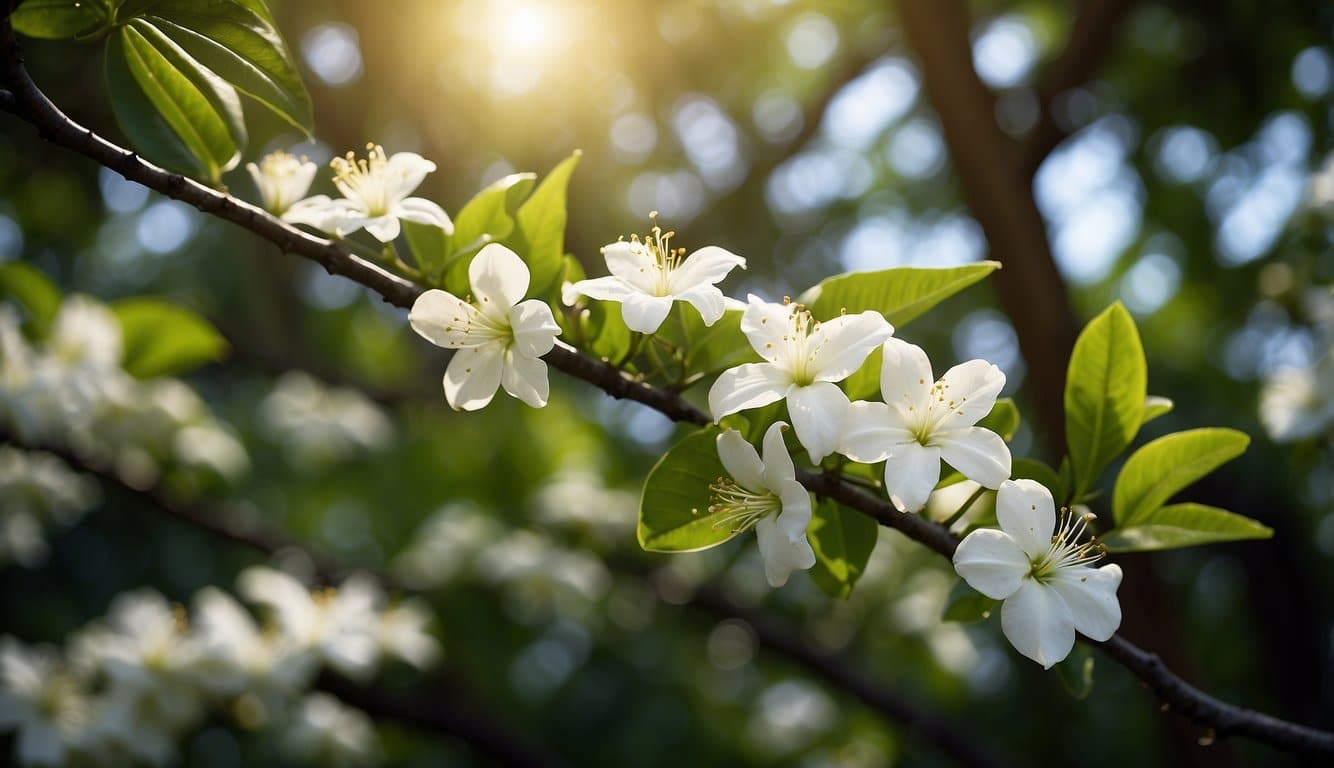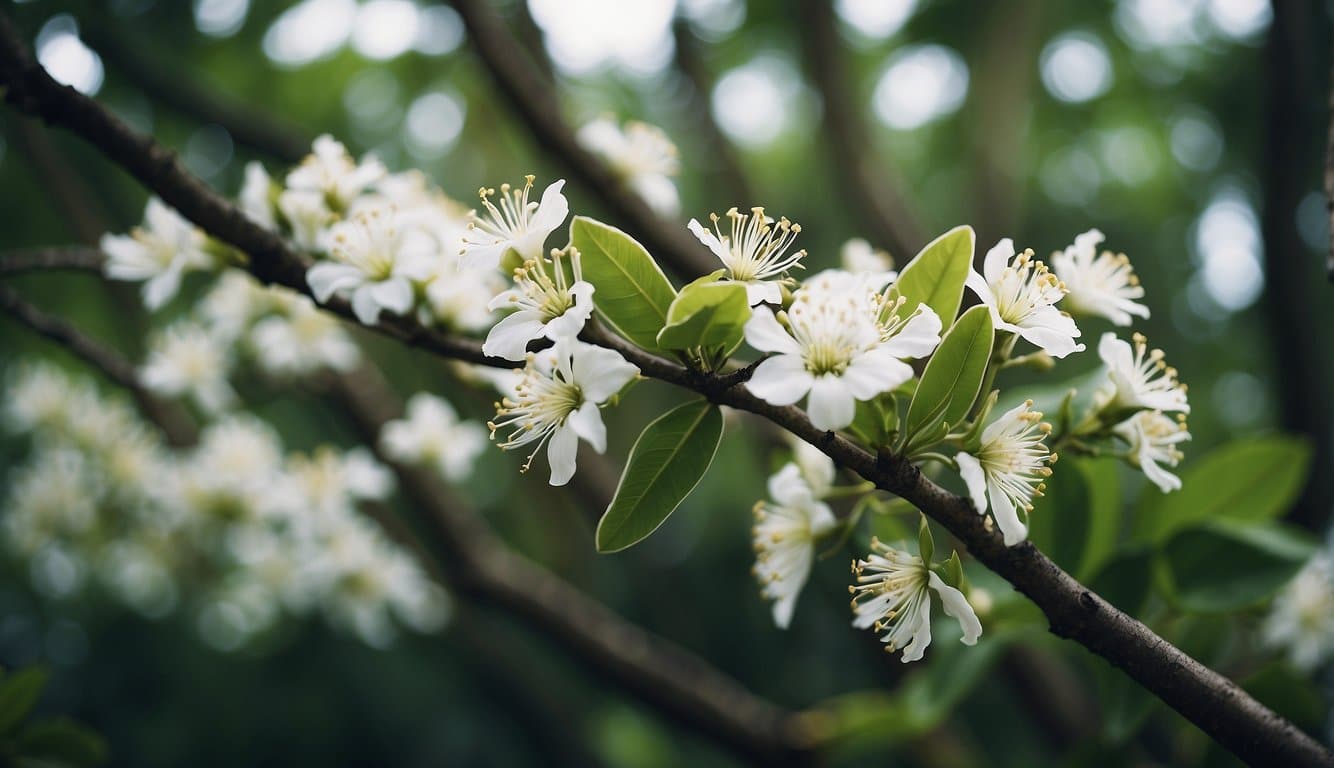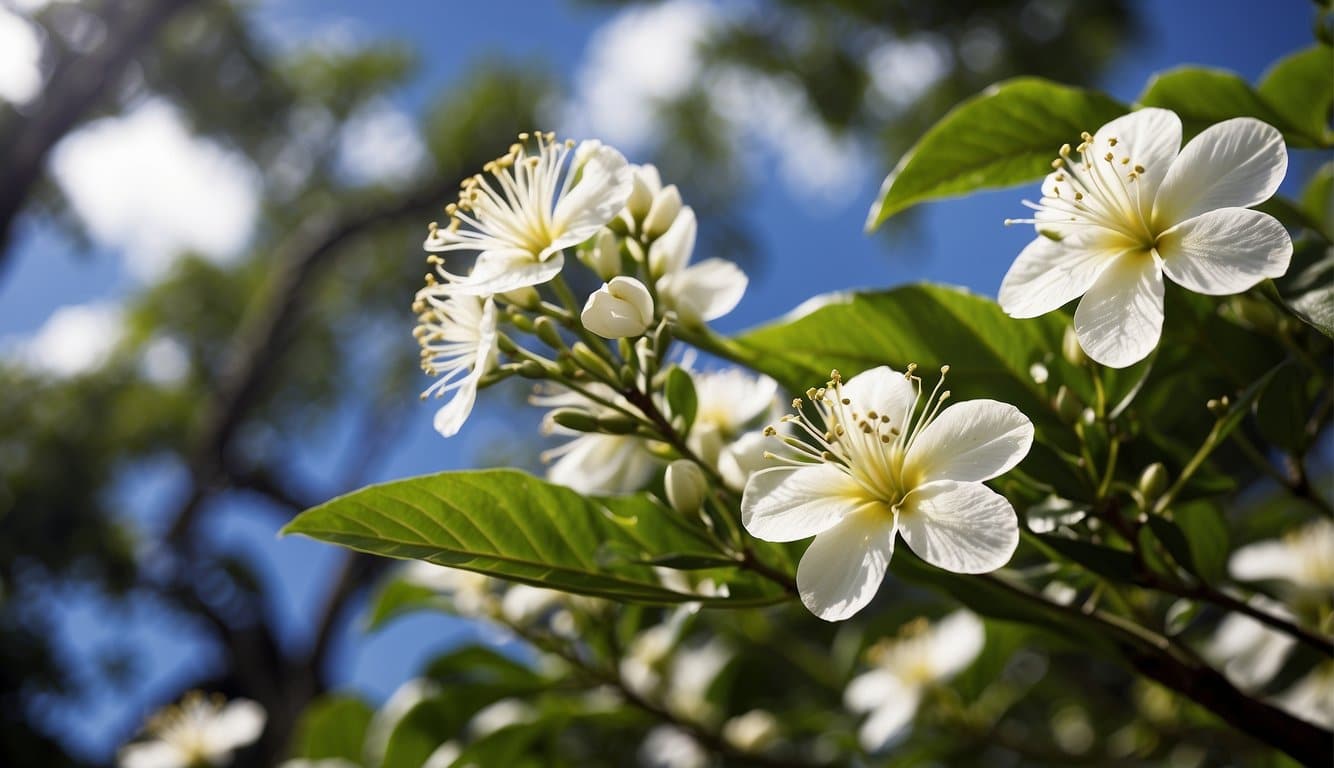Hawaii is celebrated for its vibrant and diverse flora, and amongst the most enchanting elements are the trees with white flowers that dot the landscapes.
These arboreal beauties range from the famous plumeria, known for its sweet fragrance and stunning blossoms, to the rare and striking Jade Vine.
The white blooms of these trees not only offer aesthetic splendor but also provide a unique sensory experience through their perfumed presence.

The islands’ differing altitudes and climates create a variety of habitats, supporting a wide spectrum of tree species with white flowers.
Some, like the Kokiʻo Keʻokeʻo, are indigenous to the islands and have adapted to the local conditions over millennia.
The significance of these trees extends beyond the ecological: they are intricately woven into the culture and traditions of Hawaii’s people.
Conservation efforts are crucial to protect these species, several of which face threats from habitat loss and invasive species.
Key Takeaways
- Hawaii’s white-flowered trees are as diverse as they are beautiful.
- These trees are integral to the islands’ ecology and culture.
- Conservation initiatives are vital for the protection of Hawaii’s unique arboreal species.
Prominent Trees with White Flowers in Hawaii
Hawaii’s flora includes a variety of trees renowned for their stunning white blooms. These species add a distinct charm to the islands’ landscapes, epitomizing the tropical beauty.
Koki’o Ke’oke’o (Hibiscus Arborus)
The Koki’o Ke’oke’o, also known as the Hawaiian White Hibiscus, stands out with its pure white flowers that can span up to eight inches in diameter.
This native hibiscus is revered for its large, showy blossoms that contrast beautifully against its dark green foliage.
White Plumeria (Plumeria Alba)
White Plumeria, with its intoxicating fragrance and spiraled petals, is an iconic tree in Hawaiian landscapes.
These flowers are commonly used in leis and emit a strong, sweet scent, especially in the evening.
Nānū (Gardenia Brighamii)
The Nānū or Hawaiian Gardenia is a rare endemic tree featuring creamy white flowers.
Its distinctive, velvety blossoms and glossy, dark green leaves make it a valuable component of native Hawaiian plant communities.
White Hibiscus (Hibiscus Waimeae)
Hibiscus Waimeae is one of the few species of hibiscuses worldwide that have fragrant flowers.
The white blooms of this species have a distinctive lemony scent and are set against heart-shaped leaves, adding a delicate elegance to the Hawaiian flora.
Habitats and Ecology
Hawaiian trees with white flowers thrive in diverse environments, each with unique characteristics that influence the flora.
Their presence in various ecosystems underscores a dynamic interplay with native wildlife and climatic conditions.
Forest Ecosystems
In the lush forest ecosystems of Hawaii, trees such as the Carnation Tree (Tabebuia) become key players.
They typically inhabit mid-elevation rainforests, providing understory layers beneath taller canopy species.
These trees play a crucial role in the ecology by supporting native birds and insects with their blossoms.
Volcanic Landscapes
Volcanic landscapes offer a stark contrast to Hawaii’s rainforests, but even here, certain trees with white flowers adapt and flourish.
The rich volcanic soil provides a fertile ground for robust growth once the area stabilizes post-eruption.
Trees in these areas must tolerate wide temperature fluctuations and nutrient-rich, but often porous, soils.
Coastal Areas
The coastal areas of Hawaii create a unique ecological niche where tree species must withstand high levels of salt and wind exposure.
Trees in these regions are often hardy, with deep root systems that stabilize sandy soils. Their flowers not only add aesthetic value but also serve as a food source for coastal wildlife.
Cultural Significance
Hawaii’s trees with white flowers hold a profound place in the local culture. They are not only important to the ecosystem but also possess deep-seated cultural and mythological significance.
Traditional Uses
- Carnation Tree (Tabebuia)
- Known locally as the Tabebuia, this tree has white, trumpet-shaped flowers. They have a history of being integrated into the Hawaiian landscape for their aesthetic appeal.
- Nanu (Na’u)
- A small native tree, Nanu is recognized for its fragrant white flowers. These are important not only ecologically but also hold value for their traditional uses in lei making and other cultural crafts.
Symbolism and Mythology
- ʻŌhiʻa Lehua (Metrosideros polymorpha)
- Although known for its red flowers, the ʻŌhiʻa Lehua also produces white blossoms. It is rooted in Hawaiian mythology and deeply associated with the goddess Pele. The tree and its flowers are often part of folklore and embody various symbolically rich stories.
- Hibiscus
- While not all hibiscus flowers are white, those that are, carry symbolic meaning connected to love and beauty. They are commonly associated with the Hawaiian goddess Pele and feature prominently in local art, music, and dance.
Conservation Efforts
Conservation efforts in Hawaii are crucial for sustaining the unique flora of the region. They focus on controlling invasive species, restoring native habitats, and protecting native plants.
Invasive Species Control
Hawaii’s ecosystems are particularly vulnerable to invasive species, which can quickly outcompete native flora.
Initiatives such as the introduction of a parasitoid wasp have been used to combat the invasive gall wasp affecting the Wiliwili trees.
Eradication and control programs are essential to curtail the spread of non-native species that threaten the islands’ biodiversity.
- Targeted Species for Control:
- Gall wasp (Quadrastichus erythrinae)
- Invasive plants like nutsedge and inkberry
Habitat Restoration
Restoration of native habitats involves not only the removal of invasive species but also the replanting and nurturing of indigenous plants.
On islands like Kauai, restoration projects are underway to revive the white Kauai rosemallow, an endangered species.
These projects are often collaborative efforts between botanists, local communities, and conservation organizations.
- Key Restoration Projects:
- White Kauai rosemallow habitat recovery
- Native forest regeneration on various islands
Native Species Protection
Protecting Hawaii’s native species such as the ohia tree, whose populations are threatened by fungal pathogens, requires ongoing research and monitoring.
Conservationists employ various strategies to safeguard these plants, including the growth of species in nurseries and the careful transplantation to suitable habitats.
- Protection Strategies:
- Monitoring of fungal pathogen spread
- Conservation and propagation of endangered species
Frequently Asked Questions
Hawaii’s diverse flora includes several species of trees with white flowers, each possessing unique characteristics.
What is the name of the tropical tree in Hawaii with white blossoms?
The Tabebuia, otherwise known as the Carnation Tree, is a tropical Hawaiian tree celebrated for its clusters of white, trumpet-shaped flowers.
How can I identify the white-flowered trees native to Hawaii?
White-flowered trees native to Hawaii can be identified by their distinctive flowers, leaf patterns, and growth habits.
For example, the native Wiliwili tree can be recognized by its bright green leaves and the seasonal appearance of its red blossoms.
Which are the most common white-flowering trees found in Hawaii?
Some of the most common white-flowering trees in Hawaii include the Hawaiian Gardenia and the Plumeria, both of which are renowned for their fragrant white blooms.
What are the characteristics of Hawaiian plumeria with white flowers?
Hawaiian Plumeria with white flowers typically features a sweet fragrance and five-petaled blossoms with a yellow center.
These trees are commonly found throughout the Hawaiian Islands and are a staple in Hawaiian lei making.
Are there any small white-flowered trees endemic to Hawaii?
The Hawaiian Gardenia, also known as Nau, is a small tree endemic to Hawaii.
It usually grows no taller than 12 feet and is prized for its delicate white flowers and mild scent.
Can you provide images of popular Hawaiian trees with white flowers?
While textual descriptions can provide helpful information, viewing images is an excellent way for individuals to familiarize themselves with the popular trees.
Many online horticultural databases and local Hawaiian gardening resources offer extensive image galleries for reference.

